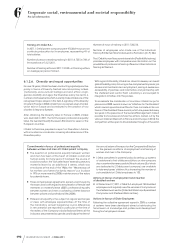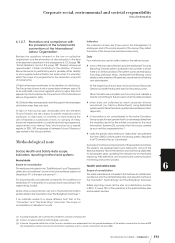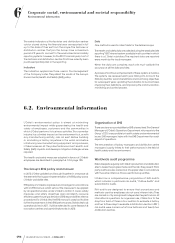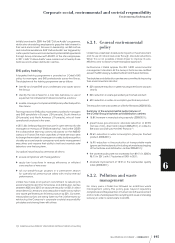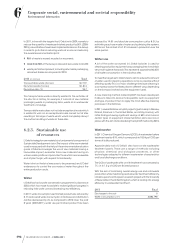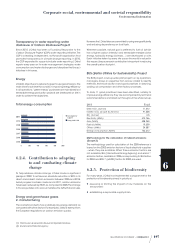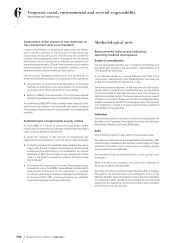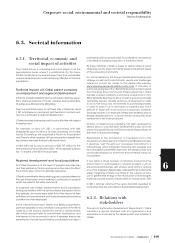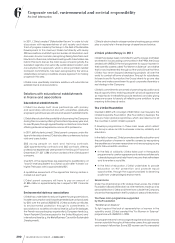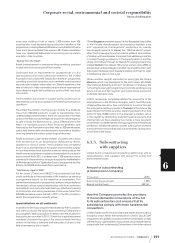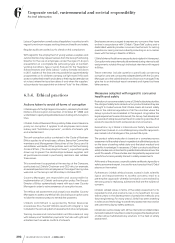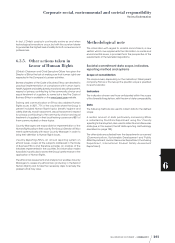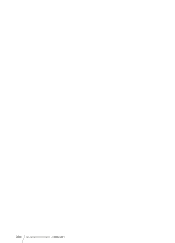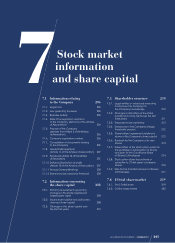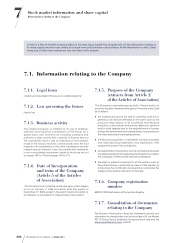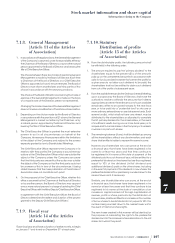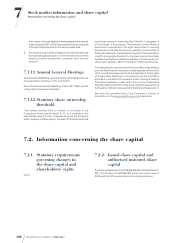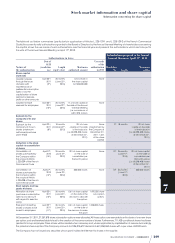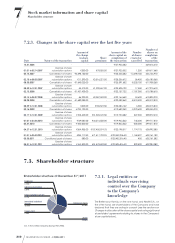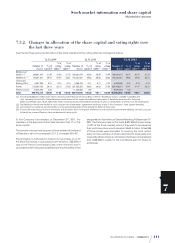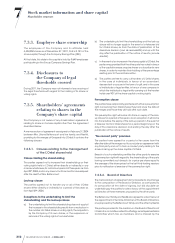Loreal 2011 Annual Report Download - page 204
Download and view the complete annual report
Please find page 204 of the 2011 Loreal annual report below. You can navigate through the pages in the report by either clicking on the pages listed below, or by using the keyword search tool below to find specific information within the annual report.
202 REGISTRATION DOCUMENT − L’ORÉAL 2011
6Corporate social, environmental and societal responsibility
Societal information
Labour Organisation as well as local legislation, in particular with
regard to minimum wages, working time and health and safety.
Regular audits are carried out to check on this compliance.
With regard to the employment of young workers, suppliers and
subcontractors may request waivers from the Group Purchasing
Director for the use of employees under the age of 16 upon
presentation of a complete file (schooling, type of contract,
working conditions, type of work). Pursuant to the “Suppliers/
Subcontractors and Child Labour ” policy, formally laid down
in2011, waivers of this kind are only possible for apprenticeship
programmes or for children carrying out light work if this work
does not affect their health and safety or their regular attendance
at school, where the local law allows it and when the supplier/
subcontractor has appointed an internal “ tutor” for the children.
6.3.4. Ethical practices
Actions taken to avoid all forms of corruption
L’Oréal supports the fight against corruption, abides by the United
Nations Anti-Corruption Convention of October31st, 2003 and
undertakes to apply all applicable laws, including anti-corruption
laws.
L’Oréal’s Code of Business Ethics publicly states a zero-tolerance
policy on corruption. It applies to all employees and covers
bribery and “facilitation payments”, conflicts of interests, gifts
and entertainment.
The anti-corruption policy contained in the Code of Business
Ethics applies to all employees, officers, Executive Committee
members and M anagement E xecutives of the Group and its
subsidiaries worldwide. Other policies such as the Purchasing
Code of Ethics (“Our Everyday Purchases”), a practical guide
drawn up to govern the relationships between suppliers and
all purchasers involved in purchasing decisions, also address
these issues.
This commitment is supported at the very top of the Company,
particularly by L’Oréal’s Chairman and CEO who, for example,
answered questions from employees on this subject during a live
webchat, on the Group’s last Ethics Day in October2011.
Country Managers are responsible and accountable for
implementation of L’Oréal’s anti-corruption policy. The Group’s
Director of Ethics systematically meets with each new Country
Manager in order to raise awareness of corruption issues.
The ethical risk assessment and analysis tool enables Country
Managers to assess any ethical risks (including corruption) and
to take the necessary steps to remedy the problems.
L’Oréal’s commitment is supported by Human Resources
procedures. Thus, the skill “Obtains results with integrity” is now
included in the annual system of assessment of all our employees.
Training courses and communication on Ethics deal not only
with bribery and “facilitation payments” but also with gifts and
entertainment, as well as conflicts of interests.
Employees are encouraged to express any concerns they have
on-line in accordance with L’Oréal’s “Open Talk” policy, and a
dedicated website provides a secure mechanism for asking
questions or raising concerns directly, including on a no-names
basis, with the Group’s Director of Ethics.
L’Oréal’s Internal Audit terms are particularly vigilant in this respect.
Corruption risks are systematically reviewed during internal audit
assignments, notably through individual interviews with regard
to Ethics.
These interviews include questions specifically concerning
corruption and are conducted independently with the Country
Manager and the administrative and financial manager. They
give rise to an individual report reviewed and signed by these
latter persons.
Measures adopted with regard to consumer
health and safety
Protection of consumer safety is one of L’Oréal’s absolute priorities.
The stringent safety tests carried out on products before they are
brought to market ensure that L’Oréal meets all current safety
rules in the national regulations of all the countries where the
Group’s products are marketed. In this respect, long before the
legal requirements were introduced, the Group had already set
up a product safety assessment team in order to guarantee that
products are safe for both professionals and consumers.
Evaluations by L’Oréal’s International Safety Assessment
Department, based on a multidisciplinary scientific approach,
are carried out at all stages of the product life cycle.
The product safety evaluation is based on a complex process:
assessment of the safety of each ingredient of all finished products
on the basis of existing safety data and the latest medical and
scientific knowledge. If necessary, L’Oréal conducts additional
safety studies subcontracted to qualified laboratories all over the
world. The results of these studies are interpreted by experienced
scientists who are specially trained in safety assessments.
At the end of the process, a specific safety certificate, signed by a
safety assessment expert, is issued for each product that L’Oréal
places on the market.
Furthermore, L’Oréal’s ethical values, rooted in both scientific
rigour and responsiveness to societal concerns, lead to a
pre-emptive approach whereby formulations are evolved by
removing and/or replacing substances that are the subject of
concern.
L’Oréal’s added value, in terms of the safety assessment of its
ingredients and end products, lies in its investment for over
twenty years in the development of predictive methods and
tissue engineering. For many years, L’Oréal has been investing
in science and technology to create new assessment tools which
are used every day by safety assessors.
L’Oréal also works closely with all the international stakeholders
involved in relevant industries in order to progress the development
of alternative multidisciplinary solutions in the field of safety
assessment.


